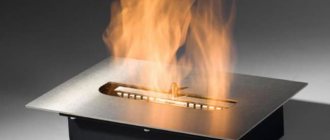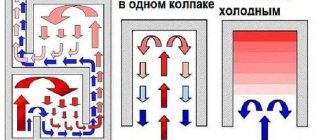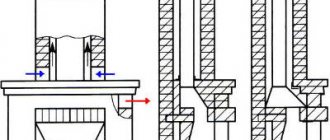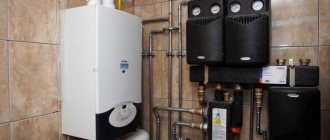Hydrogen is an almost ideal fuel for our planet. The only problem is that it is found on the planet only in combination with other substances. In its pure form, hydrogen on Earth is only 0.00005%. In this regard, the issue of designing hydrogen generators is very relevant. Do not forget that hydrogen is an endless source of energy, practically located under our feet.
Selected points of use
First of all, I would like to note that the traditional method of burning natural gas or propane is not suitable in our case, since the combustion temperature of HHO is more than three times higher than that of hydrocarbons.
As you yourself understand, structural steel will not withstand this temperature for long. Stanley Meyer himself recommended using a burner of an unusual design, the diagram of which is given below. Scheme of a hydrogen burner designed by S. Meyer
The whole trick of this device is that HHO (indicated by the number 72 in the diagram) passes into the combustion chamber through valve 35. The burning hydrogen mixture rises through channel 63 and simultaneously carries out the ejection process, entraining outside air through adjustable openings 13 and 70. Under the hood 40, a certain amount of combustion products (water vapor) is retained, which enters the combustion column through channel 45 and mixes with the burning gas. This allows you to reduce the combustion temperature several times.
The second point that I would like to draw your attention to is the liquid that should be poured into the installation. It is best to use prepared water that does not contain heavy metal salts. The ideal option is distillate, which can be purchased at any auto store or pharmacy.
For successful operation of the electrolyzer, potassium hydroxide KOH is added to the water, at the rate of approximately one tablespoon of powder per bucket of water.
And the third thing we place special emphasis on is safety. Remember that it was not by chance that the mixture of hydrogen and oxygen was called explosive. HHO is a hazardous chemical that can cause an explosion if not handled properly. Follow safety rules and be especially careful when experimenting with hydrogen. Only in this case, the “brick” that our Universe consists of will bring warmth and comfort to your home.
We hope you found this article a source of inspiration and will roll up your sleeves and start making a hydrogen fuel cell. Of course, all our calculations are not the ultimate truth, however, they can be used to create a working model of a hydrogen generator. If you want to completely switch to this type of heating, then the issue will have to be studied in more detail. Perhaps your installation will become the cornerstone, thanks to which the redistribution of energy markets will end, and cheap and environmentally friendly heat will enter every home.
Installation safety
Many craftsmen place plates in plastic containers. You shouldn't skimp on this. You need a stainless steel tank. If it is not there, you can use a design with open plates. In the latter case, it is necessary to use a high-quality current and water insulator for reliable operation of the reactor.
It is known that the combustion temperature of hydrogen is 2800. This is the most explosive gas in nature. Brown's gas is nothing more than an “explosive” mixture of hydrogen. Therefore, hydrogen generators in road transport require high-quality assembly of all system components and the presence of sensors to monitor the progress of the process.
A working fluid temperature sensor, pressure sensor and ammeter will not be superfluous in the design of the installation. Particular attention should be paid to the water seal at the outlet of the reactor. It is vital. If the mixture ignites, such a valve will prevent the flame from spreading into the reactor.
A hydrogen generator for heating residential and industrial premises, operating on the same principles, is distinguished by several times greater reactor productivity. In such installations, the absence of a water seal poses a mortal danger. In order to ensure safe and reliable operation of the system, it is also recommended to equip hydrogen generators on cars with such a check valve.
Required performance
In order to truly save fuel, a hydrogen generator for a car must produce gas every minute at the rate of 1 liter per 1000 engine displacement. Based on these requirements, the number of plates for the reactor is selected.
To increase the surface of the electrodes, it is necessary to treat the surface with sandpaper in a perpendicular direction. This treatment is extremely important - it will increase the working area and avoid “sticking” of gas bubbles to the surface.
The latter leads to isolation of the electrode from the liquid and prevents normal electrolysis. Do not also forget that for normal operation of the electrolyzer, the water must be alkaline. Regular soda can serve as a catalyst.
Brown's Gas
Today, hydrogen generators are gaining popularity among car enthusiasts. However, this is not exactly what was discussed above. By electrolysis, water is converted into the so-called Brown's gas, which is added to the fuel mixture. The main task that this gas solves is complete combustion of the fuel. This serves to increase power and reduce fuel consumption by a decent percentage. Some mechanics have achieved savings of 40%.
The surface area of the electrodes is of decisive importance in the quantitative gas yield. Under the influence of an electric current, a water molecule begins to decompose into two hydrogen atoms and one oxygen. When burned, such a gas mixture releases almost 4 times more energy than the combustion of molecular hydrogen. Therefore, the use of this gas in internal combustion engines leads to more efficient combustion of the fuel mixture, reduces the amount of harmful emissions into the atmosphere, increases power and reduces the amount of fuel consumed.
Advantages and disadvantages of gas generators
A factory-made household gas generator will cost 1.5–2 times more than a conventional solid fuel boiler. Is it worth spending money on this “miracle technology”?
Among the advantages of using gas generators are:
- complete combustion of fuel loaded into the firebox and a minimum volume of ash;
- relatively high efficiency when working together with an internal combustion engine or a gas boiler;
- wide selection of solid fuels;
- ease of operation and no need to continuously monitor the operation of the unit;
- the time interval between reboots of the firebox is up to a day with wood and up to a week with coal;
- the possibility of using undried wood - wet raw materials can only be used in some models of gas generators;
- environmental friendliness of the device - this device does not have an exhaust pipe, all the generated gas goes directly into the combustion chamber of the engine or boiler.
When using wet firewood, the generator will work, but gas production will be reduced by 20–25%. The drop in productivity occurs due to the evaporation of natural moisture from the wood.
This leads to a decrease in the temperature in the firebox, which slows down the pyrolysis process. It is best to thoroughly dry the logs before loading them into the pyrolysis chamber. Industrial devices are fully automated; fuel is supplied to them by a screw from a nearby container.
A self-made gas generator does not offer such autonomy, but it is also quite easy to operate. You just need to fill it up with fuel from time to time.
Operating temperatures in the gas generator reach values of 1200–1500°C; its body must be made of materials that can withstand such loads
The gas generator has fewer disadvantages, but they do exist:
- poor controllability of the volumes of generated gas - when the temperature in the furnace decreases, pyrolysis stops and instead of a combustible gas mixture, a mixture of resins is formed at the outlet;
- cumbersome installation - even a homemade gas generator with an average power of 10–15 kW takes up quite a large space;
- Duration of kindling - 20–30 minutes will pass before the reactor produces the first gas.
After “warming up,” the generator stably produces a certain volume of gas mixture, which must be burned or released into the air. To make this unit with your own hands, you will need durable gas cylinders or thick steel, and this is a lot of money. But all this is paid off by the efficiency of the generator and the low cost of the original fuel.
Some gas generator models are equipped with an air blower, while others are not. The first option allows you to increase the power of the installation, but ties it to the electrical network. If you need a small generator for cooking outdoors, then you can get by with a compact unit without an air blower.
Most self-made gas generating installations operate using natural draft.
A portable gas generator with a power of 2.4 kW, powered by wood, allows you to easily prepare dinner in the country, far from civilization (+)
To heat a private home, you will need a more powerful and energy-dependent device. However, in this case, it is worth taking care of a backup electric generator, so that in the event of a network failure, you will not be left without both power supply and heating.
Exploitation
After assembly, you can begin testing the device. To do this, install a burner from a medical needle at the end of the tube and begin to pour in water. You need to add KOH or NaOH to the water. Water should be distilled or melted water as a last resort. A 10% concentration of alkaline solution is sufficient for the device to operate. There should be no leaks when pouring water. It is best to blow the structure with air, pressure up to 1 atm, before pouring. If the hydrogen generator can withstand this pressure, then you can fill it with water; if not, you need to fix the leaks.
DIY heating system installation
After this, a LATR with a diode bridge is connected to the electrodes according to the circuit. An ammeter and a voltmeter are installed in the circuit to monitor operation. Start with minimal voltage and then constantly increase it, observing gas evolution.
It is better to carry out preliminary work outdoors outside the home. Since the installation is explosive, all work should be carried out with extreme caution.
During testing, observe the operation of the device. If there is a small burner flame, then there may be either low gas emission in the generator, or there may be a gas leak somewhere. If the solution becomes cloudy or dirty, it needs to be replaced. It is also necessary to ensure that the device does not overheat and the water does not boil. To do this, regulate the voltage at the current source. And one more thing - when heated, the plates become slightly deformed and can stick to one another. To eliminate this, you need to make rubber gaskets. Water spitting may also occur - to eliminate this, you need to reduce the water level.
Hydrogen heating: myth or reality?
A generator for welding is currently the only practical application of electrolytic water splitting. It is not advisable to use it for heating a house and here's why. Energy costs during gas-flame work are not so important; the main thing is that the welder does not need to carry heavy cylinders and fiddle with hoses. Another thing is home heating, where every penny counts. And here hydrogen loses to all currently existing types of fuel.
Serial welding generators cost a lot of money because they use catalysts for the electrolysis process, which include platinum. You can make a hydrogen generator with your own hands, but its efficiency will be even lower than that of a factory one. You will definitely be able to get flammable gas, but it is unlikely to be enough to heat at least one large room, let alone an entire house. And if there is enough, you will have to pay exorbitant electricity bills.
Rather than wasting time and effort on obtaining free fuel, which does not exist a priori, it is easier to make a simple electrode boiler with your own hands. You can be sure that this way you will spend much less energy with greater benefit. However, DIY enthusiasts can always try their hand at assembling an electrolyzer at home in order to conduct experiments and see for themselves. One such experiment is shown in the video:
A little theory
It should be noted that the resonant decomposition of water into Brown gas is by no means a myth, but a real chemical process designed to release gaseous fuel from water. This gas gets its name from the inventor who first tried to take this technology beyond experimentation. Another name that appears on the Internet is detonating gas (hypothetical formula of NNO).
Brown's flammable gas is nothing more than a mixture of free hydrogen and oxygen released from water through an electrolytic reaction.
Water, whose chemical formula (H2O) is known even to children, is hydrogen, which is completely oxidized. Individually, these chemical elements are very active, hydrogen burns well and is considered an energy carrier, and oxygen supports combustion. That is why splitting water, whose price is just a penny, into such useful components has become a very popular idea.
As a result, through the efforts of various people, a generator for producing gas - an electrolyzer - was born. Without going deeply into the intricacies of the process, we note that the above-mentioned apparatus uses the electrolysis method to separate Brown's gas from water, or rather, a mixture of oxygen and hydrogen. To do this, a current of optimal frequency is passed through electrodes immersed in a container of water. The resulting gas accumulates under the water seal and, when a certain pressure is reached, exits through the tube and can be used for various purposes.
Hydrogen water at home
Theoretically, you can create a hydrogen generator with your own hands at home. But for this you need to have special knowledge and have the appropriate equipment.
There are two options:
- Saturation is the process of enriching water with molecular oxygen. Based on the principle of producing carbonated drinks.
- Electrolysis is the process of passing current through a liquid medium. The essence of the technique is the reaction of water with metals.
The operating principle of a home generator is shown in the image:
The simplest electrolyzer consists of:
- thick-walled container (reactor);
- metal electrodes connected to the electrical network;
- water seal;
- gas outlet tube;
- burners.
How to make a hydrogen generator:
- Immerse the metal electrodes in a container of water and apply voltage. The reaction will be improved by adding salt (or alkali, or acid) to the water.
- A reaction will occur as a result of which hydrogen will begin to be released near the cathode (minus), and oxygen will begin to be released near the anode (plus).
- The gases are mixed and enter a tube, through which they are then sent to a water seal (hydraulic seal). The purpose of the water seal is to prevent a flash in the reactor and to separate water vapor.
- Dangerous gas from the second container is transferred to the burner, where it burns out. As a result, water is formed.
Creating a hydrogen generator in practice goes like this:
- Prepare everything you need: 2 wide-necked glass bottles, caps for them, a dropper system, 20 screws, 2 flat wooden sticks, wires.
- Connect the wooden sticks with self-tapping screws with ends in different directions. Solder the heads of the screws and connect the wires to them. You will get improvised electrodes.
- Pull the tube from the dropper and the wire into the hole in the bottle cap. Seal with a glue gun.
- Place the electrodes in the container and screw on the lid.
- Pull the tubes from the dropper through 2 holes in the other lid. Pour water into the bottle and screw on the cap.
- Pour water with added salt into the reactor.
- Turn on the power source (DC, for example, car battery, AC adapter).
- As soon as bubbles appear, the reaction has begun. Adjust the voltage. Ignite the escaping gas.
For more information on how to make a hydrogen generator with your own hands, watch the video:
But is there any point in trying to create a water ionizer yourself when it’s easier and cheaper to buy a ready-made one?
What is needed to make a fuel cell at home
Creating a hydrogen unit at home is not an easy task. You need to arm yourself not only with a number of tools, but also with relevant knowledge and diagrams.
Hydrogen generator design: diagrams and drawings
The device consists of a reactor with installed electrodes, a PWM generator for power, a water seal, wires and hoses connecting the structure. Today, several electrolyzer designs are known, where plates or tubes are used as electrodes.
Dry electrolysis devices are also popular. Unlike the classic version, in this unit the plates are not placed in a container with liquid, but the water itself is directed into the gap between the flat electrodes.
Selection of materials for the construction of a hydrogen generator
To make a generator at home, you do not need any special or unusual tools. Here's what you need to prepare:
- hacksaw for working with metal products;
- drill and drill bits for it;
- set of wrenches;
- flat and slotted screwdrivers;
- angle grinder (“grinder”) with a circle for cutting metal;
- multimeter and flow meter;
- ruler;
- marker.
How does the assembled structure work?
Voltage is applied to the shim, the regulator generates voltage at the required frequency. The productivity of gas production depends on the frequency. Voltage is then applied to the stainless steel tubes or plates that contain the water. In them, under the influence of current, a “rattle” is released. Next, it flows through flexible tubes into the dryer tank. And from the dryer, gas is supplied to the air supply circuit.
This installation can be used for heating: garage cooperatives, country houses, it all depends on the flight of your imagination. To use this installation for heating a house, you need to convert a solid fuel boiler or a gas boiler to Brown gas. If you decide to assemble and actively use this homemade installation, you will get cheap fuel. And an environmentally friendly product that does not pollute the air. When assembling a Brown gas generator, you will have questions. Here we will answer the most frequently asked questions.
What water should I use, regular tap water or distilled water?
You can use tap water if it does not contain heavy metals or distilled water. But the best effect is achieved by using a solution of sodium hydroxide added to distilled water. It is necessary to maintain the proportion: for ten liters of water you need to add one tablespoon of sodium hydroxide and mix thoroughly.
What metal should I use?
In various manuals and manuals, they write that it is necessary to use only rare metals.
You are being misled. Any stainless steel can be used. The best results when working with steel were shown by ferromagnetic steel, which does not attract particles of unnecessary debris. Another important point, the main thing is that when choosing a metal, give preference to stainless steel, and that it is not susceptible to oxidation.
How durable are the electrode plates?
There is no need to replace the plates with new ones, since they are not destroyed at all during operation.
What needs to be done to prepare the electrode plates? And how to do it correctly?
First of all, before assembling the plates, they must be washed very thoroughly in a soapy solution, and then their surface must be treated with an alcohol-containing substance (vodka or alcohol). It is necessary to “drive” the electrolyzer for some time, periodically replacing dirty water with clean water. Continue until the water has washed away all the dirt. If the water is clean enough, the installation will not heat up.
If you assembled the electrolyzer correctly, then when using it, the water and plates will not heat up
It is important not to overheat the electrolyzer above 65 degrees. If the temperature rises above the specified temperature, then dirt, metals and minerals will stick to the plates. And they will have to be removed with sandpaper or replaced with new ones
And they will have to be removed with sandpaper or replaced with new ones.
Current regulator
A hydrogen generator on a car increases its productivity during operation. This is due to the release of heat during the electrolysis reaction. The working fluid of the reactor experiences heating, and the process proceeds much more intensely. To control the progress of the reaction, a current regulator is used.
If you do not lower it, the water may simply boil and the reactor will stop producing Brown gas. A special controller that regulates the operation of the reactor allows you to change productivity with increasing speed.
Carburetor models are equipped with a controller with a conventional switch for two operating modes: “Highway” and “City”.
DIY electrolyzer for a car
On the Internet you can find many diagrams of HHO systems, which, according to the authors, allow you to save from 30% to 50% of fuel. Such statements are too optimistic and, as a rule, are not supported by any evidence. A simplified diagram of such a system is shown in Figure 11.
In theory, such a device should reduce fuel consumption due to its complete burnout. To do this, Brown's mixture is supplied to the fuel system air filter. This is hydrogen and oxygen obtained from an electrolyzer powered from the car’s internal network, which increases fuel consumption. Vicious circle.
Of course, a PWM current regulator circuit can be used, a more efficient switching power supply can be used, or other tricks can be used to reduce energy consumption. Sometimes on the Internet you come across offers to purchase a low-ampere power supply for an electrolyzer, which is generally nonsense, since the performance of the process directly depends on the current strength.
This is like the Kuznetsov system, the water activator of which is lost, and the patent is missing, etc. In the above videos, where they talk about the undeniable advantages of such systems, there are practically no reasoned arguments. This does not mean that the idea has no right to exist, but the declared savings are “slightly” exaggerated.
Application area
Today, an electrolyzer is as common a device as an acetylene generator or a plasma cutter. Initially, hydrogen generators were used by welders, since carrying a unit weighing only a few kilograms was much easier than moving huge oxygen and acetylene cylinders. At the same time, the high energy intensity of the units was not of decisive importance - everything was determined by convenience and practicality. In recent years, the use of Brown's gas has gone beyond the usual concepts of hydrogen as a fuel for gas welding machines. In the future, the possibilities of the technology are very wide, since the use of HHO has many advantages.
- Reducing fuel consumption in vehicles. Existing automotive hydrogen generators allow the use of HHO as an additive to traditional gasoline, diesel or gas. Due to more complete combustion of the fuel mixture, a 20–25% reduction in hydrocarbon consumption can be achieved.
- Fuel savings at thermal power plants using gas, coal or fuel oil.
- Reducing toxicity and increasing the efficiency of old boiler houses.
- Multiple reductions in the cost of heating residential buildings due to the complete or partial replacement of traditional fuels with Brown gas.
- Using portable HHO production units for domestic needs - cooking, obtaining warm water, etc.
- Development of fundamentally new, powerful and environmentally friendly power plants.
A hydrogen generator built using S. Meyer’s “Water Fuel Cell Technology” (that’s what his treatise was called) can be bought - many companies in the USA, China, Bulgaria and other countries are engaged in their production. We propose to make a hydrogen generator yourself.
Law of conservation of energy ↑
Everything in nature is interconnected. If something has arrived somewhere, it means it has left somewhere. This folk wisdom simplifies, but generally correctly describes the law of conservation of energy. Hydrogen, when burned, releases thermal energy. But to produce gas by electrolysis, you will have to spend a certain amount of electricity. Which, in turn, is largely obtained through the generation of heat when burning other types of fuel. And if we take the clean thermal energy necessary to generate electricity and the energy that hydrogen will provide during combustion, even the most advanced installations result in double losses. We literally throw away half the money. And these are only operating costs, but you should also take into account the cost of very expensive equipment.
AeromodellerII wind-hydrogen airship project. Belgian engineers painted a beautiful picture, all that remains is to back it up with specific economically feasible technologies
According to the INEEL research laboratory, in US industrial hydrogen generators the cost of one kilogram of hydrogen was:
- Electrolysis from an industrial power supply - 6.5 usd.
- Electrolysis from wind generators - 9 usd.
- Photoelectrolysis from solar devices - 20 usd.
- Production from biomass - 5.5 usd.
- Conversion of natural gas and coal - 2.5 usd.
- High-temperature electrolysis at nuclear power plants - 2.3 usd. This is the least expensive method and the furthest away from home conditions.
Moreover, even the best hydrogen generator at home will be noticeably inferior in efficiency to an industrial one. With such prices, there is no reason to talk about any serious competition for hydrogen fuel compared not only with cheap natural gas, but also with expensive electric heating, diesel fuel and even heat pumps.
A little about gullibility and naivety
Some enterprising businessmen offer for sale a hydrogen generator for cars. They talk about laser processing of the surface of electrodes or about the unique secret alloys from which they are made, special water catalysts developed in scientific laboratories around the world.
It all depends on the ability of the thoughts of such entrepreneurs to fly scientifically. Credulity can make you, at your own expense (sometimes not even small ones), the owner of an installation whose contact plates will collapse after two months of operation.
If you decide to save money in this way, then it is better to assemble the installation yourself. At least there will be no one to blame later.
How to make hydrogen heating with your own hands
Any craftsman who has the ability to work with metal can make hydrogen heating with his own hands.
To form the device you will need the following set of materials:
- stainless steel sheet with parameters 50x50 cm;
- bolts 6x150, equipped with washers and nuts;
- flow-through filter element - useful from an old washing machine;
- a transparent hollow tube 10 m long, for example, from the water level;
- a regular 1.5-liter food-grade plastic container with a durable sealed lid;
- a set of herringbone fittings with a hole diameter of 8 mm;
- grinder for cutting;
- drill;
- silicone sealant.
To make a hydrogen furnace, steel 03Х16Н1 is suitable, and instead of water you can take an alkaline solution, which will create an aggressive environment for the passage of current, while extending the life of the steel sheets.
How to heat your home with hydrogen yourself:
- Place the metal sheet on a flat table and cut into 16 equal parts. The result is rectangles for the future burner. Now cut off one corner of all 16 rectangles - this is necessary for the subsequent connection of the parts.
- Drill a hole for a bolt on the back of each element. Of all 16 sheets, 8 will be anodes and 8 will be cathodes. Anodes and cathodes are needed to pass electric current through parts with different polarities, this ensures the decomposition of alkali or distillate into hydrogen and oxygen.
- Now place the plates in a plastic container, taking into account the polarity, alternating plus and minus. The insulator of the plates will be a transparent tube, which needs to be cut into rings, and then into strips 1 mm thick.
- The metal plates are fixed together with washers in this way - first the washer is put on the bolt leg, then the plate is put on. After the plate, you need to put 3 washers on the bolt, then the plate again. In this way, 8 plates are hung on the anode and 8 plates on the cathode.
Now you need to find out the stop point for the bolt in the food container and drill a hole in this place. If the bolts do not fit into the container, then the bolt leg is cut to the required length. After this, thread the bolts into the holes, put washers on the legs and tighten the structure with nuts to seal it. Equip the container lid with a hole for the fitting, insert the element into the hole and coat the joint area with sealant to ensure a tight seal. Now blow out the fitting. And if air escapes through the lid, then you will have to seal the lid around the entire perimeter.
The generator is tested by connecting any current source and filling the container with water. A hose is put on the fitting, the second end of which is immersed in a container. If air bubbles form in the liquid, then the circuit is working; if not, you need to check the current supply power. It happens that no air bubbles form in the water, but they definitely appear in the electrolyzer.
To provide the required amount of thermal energy, it is necessary to increase the production and output of gas by increasing the voltage in the electrolyte. Pour an alkali into the water, for example, sodium hydroxide, which is found in the “Mole” pipe cleaner. Reconnect the power supply and check the power of the electrolyser.
The very last stage is connecting the burner to the heating main pipeline. This could be a warm floor, baseboard wiring. The joints should be sealed with silicone and the equipment can be put into operation.
Hydrogen generator design
To build hydrogen generators with your own hands, they usually take Brown’s classic installation scheme as a basis. This medium-power electrolyser consists of a group of cells, each of which contains a group of plate electrodes. The power of the installation is determined by the total surface area of the plate electrodes.
The cells are placed inside a container well isolated from the external environment. The tank body has pipes for connecting the water main, hydrogen outlet, as well as a contact panel for connecting electricity.
Hydrogen generation apparatus designed according to Brown's scheme. By all calculations, this installation should fully provide the household with heat and light. Another question is what dimensions and power will allow this to be done (+)
The Brown generator circuit, among other things, provides for the presence of a water seal and a check valve. Due to these elements, the installation is protected from hydrogen backflow. According to this scheme, it is theoretically possible to assemble a hydrogen installation, for example, to organize heating of a country house.
Features of hydrogen heating
This type of heating was developed by Italian engineers. The result of their work was a device that not only did not emit harmful substances into the atmosphere, but also created virtually no noise. And for the manufacture of the boiler, heat-resistant steel or cast iron was not required, since the temperature inside the unit was low.
As mentioned above, as a result of such chemical reactions, harmful substances are not released into the atmosphere, and therefore a complex system for their removal is not required. And obtaining raw materials is currently not as serious a problem as it used to be. As for costs, in addition to the fuel itself, it usually also includes electricity for the uninterrupted operation of the hydrogen boiler.
Pros and cons of hydrogen heating at home
Such heating systems have recently become more and more popular, thanks to such advantages as:
- No harmful emissions into the atmosphere.
- There is no fire in low temperature systems because the heat is the result of a chemical reaction. When oxygen and hydrogen combine, water and heat are obtained, which is transferred to the heat exchanger. As a result, the coolant does not heat up above forty degrees Celsius, which is the ideal temperature for a “warm floor” system.
- Economical - only using gas boilers will allow you to save more, but this type of heating is not always available in rural areas even now.
- In addition, this makes it possible in the future to reduce the consumption of non-renewable resources such as gas or oil.
But hydrogen heating also has disadvantages:
- It is best to use only low-temperature versions of such devices, since fuel is explosive.
- It is still not easy to find a highly qualified specialist for competent installation and maintenance of such devices.
The design and principle of operation of a hydrogen installation for heating a house
As a result of the reaction of hydrogen and oxygen, water is produced and a significant amount of heat is released. Such a process, characterized by high efficiency (more than 80 percent), requires large capacities. In addition, you need to be constantly connected to a water source, which is usually played by the house’s plumbing system; electricity for the electrochemical reaction of electrolysis, the availability and constant renewal of special catalysts.
This process must be accompanied by human control and compliance with all safety requirements. Although there are much fewer of them than in the case of gas heating. Typically, only periodic visual monitoring of the process is required.
If you want to create such a system with your own hands, then at a minimum you will need:
- hydrogen generator;
- burner;
- boiler.
The first device is necessary for electrolysis - the decomposition of water into components, using electricity and catalysts. An open flame is created using a burner. The boiler is used as a heat exchange device. All these components can be purchased in stores and you can assemble the system yourself.
You can also assemble a hydrogen generator yourself. To do this, you will need a power source providing a current of 30A, a tank for the location of all structures, steel tubes, and a container for distilled water. Stainless steel plates are installed inside the sealed structure - and the more of them, the more hydrogen the installation will produce (but it will also consume more electricity).
The water entering the container is split under the influence of an electric current into hydrogen and oxygen, the first of which is sent to the boiler with a burner. Let us add that if you use a PWM generator (instead of a 220V network), the efficiency of the device increases.
Do not forget that the system uses only distilled water mixed with sodium hydroxide (a solution for the preparation of which is 1 tablespoon of the substance per 10 liters of liquid). If it is difficult to obtain distillate, you can use tap water. The main thing is to make sure that heavy metals are not dissolved in such a liquid.
As you can see, if you approach the design and selection of materials wisely, it is quite possible to make a hydrogen boiler yourself.
Industrial generator
At the level of industrial production, technologies for manufacturing hydrogen generators for household use are gradually being mastered and developed. As a rule, energy stations for home use are produced, the power of which does not exceed 1 kW.
Such a device is designed to produce hydrogen fuel in continuous operation for no more than 8 hours. Their main purpose is to supply energy to heating systems.
Installations for operation within condominiums are also developed and manufactured. These are already more powerful designs (5-7 kW), the purpose of which is not only the energy of heating systems, but also the generation of electricity. This combination option is quickly gaining popularity in Western countries and Japan.
Combined hydrogen generators are characterized as systems with high efficiency and low carbon dioxide emissions.
An example of a real-life industrially manufactured station with a power of up to 5 kW.
In the future, it is planned to make similar installations for equipping cottages and condominiums. Russian industry has also begun to engage in this promising type of fuel production. In particular, Norilsk Nickel is mastering technologies for the production of hydrogen installations, including household ones.
It is planned to use a variety of fuel cell types during development and production:
- proton exchange membrane;
- orthophosphoric acid;
- proton exchange methanol;
- alkaline;
- solid oxide.
Meanwhile, the electrolysis process is reversible. This fact suggests that it is possible to obtain already heated water without burning hydrogen.
It seems that this is just another idea that, if you grab onto it, you can launch a new round of passions related to the free production of fuel for your home boiler.
Hydrogen engine: types, device, principle of operation
TYPES OF HYDROGEN ENGINES
The first type of hydrogen engine runs on fuel cells. Unfortunately, hydrogen engines of this type are still very expensive. The fact is that the design contains expensive materials like platinum.
The second type includes hydrogen internal combustion engines. The operating principle of such devices is very similar to propane models. That is why they are often reconfigured to run on hydrogen. Unfortunately, the efficiency of such devices is an order of magnitude lower than those operating on fuel cells.
DEVICE AND PRINCIPLE OF OPERATION
The main difference between hydrogen engines and the gasoline or diesel analogues we are now familiar with is the method of supplying and igniting the working mixture. The principle of converting the reciprocating movements of the crankshaft into useful work remains unchanged. Due to the fact that fuel based on petroleum products burns slowly, the combustion chamber is filled with the fuel-air mixture a little before the moment the piston rises to its highest position (TDC). The lightning-fast reaction speed of hydrogen makes it possible to shift the injection time to the moment when the piston begins its return movement to BDC. In this case, the pressure in the fuel system does not have to be high (4 atm is enough).
Under ideal conditions, a hydrogen engine can have a closed-type power supply system. The mixture formation process occurs without the participation of atmospheric air. After the compression stroke, water remains in the combustion chamber in the form of steam, which, passing through the radiator, condenses and turns back into H2O. This type of equipment is possible if an electrolyzer is installed on the car, which will separate hydrogen from the resulting water for repeated reaction with oxygen.
In practice, this type of system is still difficult to implement. To ensure proper operation and reduce friction, engines use oil, the evaporation of which is part of the exhaust gases. At the present stage of technology development, stable operation and trouble-free starting of an engine running on detonating gas without the use of atmospheric air is not feasible.
ICE on hydrogen fuel
For several decades, there has been a search for the possibility of adapting internal combustion engines for full or hybrid operation on hydrogen fuel. In Great Britain, back in 1841, an engine running on an air-hydrogen mixture was patented. At the beginning of the 20th century, the Zeppelin concern used internal combustion engines running on hydrogen as the propulsion system for its famous airships.
The development of hydrogen energy was also facilitated by the global energy crisis that erupted in the 70s of the last century. However, with its end, hydrogen generators were quickly forgotten. And this despite a lot of advantages compared to conventional fuel:
- ideal flammability of the fuel mixture based on air and hydrogen, which makes it possible to easily start the engine at any ambient temperature;
- large heat release during gas combustion;
- absolute environmental safety - exhaust gases turn into water;
- the combustion rate is 4 times higher compared to a gasoline mixture;
- the ability of the mixture to operate without detonation at a high compression ratio.
The main technical reason, which is an insurmountable obstacle to the use of hydrogen as a vehicle fuel, was the inability to fit a sufficient amount of gas on a vehicle. The size of the hydrogen fuel tank will be comparable to the parameters of the car itself. The high explosiveness of the gas should exclude the possibility of the slightest leak. In liquid form, a cryogenic installation is required. This method is also not very feasible in a car.
Methods for producing hydrogen
Hydrogen is a colorless and odorless gaseous element with a density of 1/14 relative to air. It is rarely found in a free state. Hydrogen is usually combined with other chemical elements: oxygen, carbon.
Hydrogen production for industrial needs and energy is carried out using several methods. The most popular are:
- electrolysis of water;
- concentration method;
- low temperature condensation;
- adsorption.
Hydrogen can be isolated not only from gas or water compounds. Hydrogen is produced by exposing wood and coal to high temperatures, as well as by processing biowaste.
Atomic hydrogen for energy is produced using the method of thermal dissociation of a molecular substance on a wire made of platinum, tungsten or palladium. It is heated in a hydrogen environment under a pressure of less than 1.33 Pa. Radioactive elements are also used to produce hydrogen.
Thermal dissociation
Electrolysis method
The simplest and most popular method of hydrogen separation is the electrolysis of water. It allows the production of almost pure hydrogen. Other advantages of this method are:
Operating principle of an electrolysis hydrogen generator
- availability of raw materials;
- obtaining the element under pressure;
- the ability to automate the process due to the absence of moving parts.
The procedure for splitting a liquid by electrolysis is the reverse of hydrogen combustion. Its essence is that under the influence of direct current, oxygen and hydrogen are released on electrodes immersed in an aqueous electrolyte solution.
An additional advantage is the production of by-products of industrial value. Thus, oxygen in large quantities is necessary for catalyzing technological processes in the energy sector, cleaning soil and water bodies, and recycling household waste. Heavy water produced by electrolysis is used in the energy sector in nuclear reactors.
Hydrogen production by concentration
This method is based on isolating an element from gas mixtures containing it. Thus, the largest part of the substance produced in industrial volumes is extracted using steam reforming of methane. The hydrogen produced in this process is used in the energy sector, in the oil refining industry, the rocket industry, and also for the production of nitrogen fertilizers. The process of obtaining H2 is carried out in different ways:
- short cycle;
- cryogenic;
- membrane.
The latter method is considered the most effective and less expensive.
Condensation due to low temperatures
This technique for producing H2 involves intensely cooling gas compounds under pressure. As a result, they are transformed into a two-phase system, which is subsequently separated by a separator into a liquid component and a gas. Liquid media are used for cooling:
- water;
- liquefied ethane or propane;
- liquid ammonia.
This procedure is not as simple as it seems. It is not possible to cleanly separate hydrocarbon gases in one go. Some of the components will leave with the gas taken from the separation compartment, which is not economical. The problem can be solved by deep cooling of the raw materials before separation. But this requires a lot of energy.
Modern low-temperature condenser systems additionally include demethanization or deethanization columns. The gas phase is removed from the last separation stage, and the liquid is sent to the distillation column with a flow of raw gas after heat exchange.
Adsorption method
During adsorption, adsorbents are used to release hydrogen - solid substances that absorb the necessary components of the gas mixture. Activated carbon, silicate gel, and zeolites are used as adsorbents. To carry out this process, special devices are used - cyclic adsorbers or molecular sieves. When implemented under pressure, this method allows recovery of 85% hydrogen.
If we compare adsorption with low-temperature condensation, we can note that the material and operational costs of the process are lower - on average, by 30 percent. The adsorption method produces hydrogen for energy and using solvents. This method allows for the extraction of 90 percent of H2 from the gas mixture and the production of a final product with a hydrogen concentration of up to 99.9%.
Rules for selecting a hydrogen heating boiler
The first thing you need to ask for when purchasing is a certificate of conformity for the device protection unit.
Then check the details for compliance and determine a number of basic parameters:
- Power. Choose depending on the network available in the house and the volume of the building area. For 10 m2 you need 1 kW of heat.
- Heating system parameters. For example, if the boiler heats water from +90 C, and the network operates with a coolant no higher than +80 C, the boiler power must be reduced.
- Combustion chamber volume. The indicator must correspond to the number of heat exchangers to warm the house.
- Number of circuits and technical possibility of installing additional ones. For example, for distributing hot water to different floors.
Be careful
The gas produced is an explosive mixture of hydrogen and oxygen, so it must be used with extreme caution. The container contains a lot of gas, there is a possibility of it catching fire, and if there is excess pressure, it can even cause an explosion. To avoid detonation of the gas inside the hydrogen generator, the pipes from the container must be connected to another container half filled with water. If there is a fire at the outlet, the flame does not penetrate back into the device. This safety device is absolutely necessary and must be installed.
The best concentrator models according to Tehno.guru editors
After reading many reviews on the Internet and considering the technical characteristics of many models, the Tehno.guru editorial team selected several of the best models. This should help our dear reader make the right choice without unnecessary hassle and hours of scouring the Internet in search of a good device.
"ARMED 7F-3L" - an oxygen concentrator with good functionality
This is what one of the best devices looks like - “ARMED 7F-3L” “ARMED 7F-3L” is recommended not only for home use, but also for use in kindergarten, school, and fitness center. The productivity of the device is up to 3 l/min at an oxygen concentration of 93%. Device dimensions 480 × 280 × 560 mm, weight – 26.5 kg. Suitable for preparing oxygen cocktails. Here are some of its characteristics.
| brand, model | Oxygen productivity, l/min | Noise level, dB | Power consumption, W |
| ARMED 7F-3L | 0-3 | 49 | 350 |
A little noisy, but overall a pretty decent unit. Here's what netizens say about him.
ARMED 7F-3L
"OXYbar Auto" - a product from the very famous brand "Atmung"
“OXYbar Auto” is one of the quietest and most compact devices. Very quiet, lightweight and compact device
The kit includes an adapter for connecting in a car, which is very important for many on long trips. Weight only 5.2 kg
Today there are no such lightweight devices on the Russian market. The manufacturer claims that the device can operate around the clock. The maximum productivity of the unit is 6 l/min, but the oxygen concentration will be only 30%, which is not encouraging. With a performance setting of 1 l/min, the concentration is acceptable - 90%. Let's look at the characteristics of the device.
| brand, model | Oxygen productivity, l/min | Noise level, dB | Power consumption, W |
| Atmung OXYbar Auto | 0,2-6 | 40 | 115 |
Thus, the device can be called not only the smallest, but also one of the quietest.
Atmung OXYbar Auto
"BITMOS OXY-6000" is a device with fairly good performance
"BITMOS OXY-6000" has good characteristics
| brand, model | Oxygen productivity, l/min | Noise level, dB | Power consumption, W |
| BITMOS OXY-6000 | 1-6 | 35 | 360 |
"BITMOS OXY-6000" is the brainchild of German manufacturers. And, like any German technology, it is made of very high quality. It has a very convenient shape - it is a “suitcase” on wheels, which is very convenient with a weight of 19.8 kg. The dimensions of the device are 520 × 203 × 535 mm. There is a function for preparing oxygen phyto-cocktails. When the temperature rises, the flow rate drops, the oxygen concentration drops, the network turns off and microprocessor errors, the device sounds an audible signal. At a productivity of 1-4 l/min, the oxygen concentration reaches 95%. What about the characteristics?
BITMOS OXY-6000
HELPFUL INFORMATION!
The cost of such devices is quite high and not everyone can afford it. That is why today you can find many companies offering oxygen concentrators for home use for rent at very reasonable prices.











